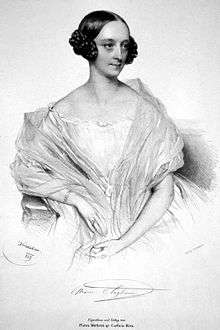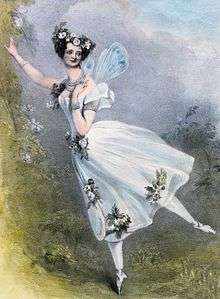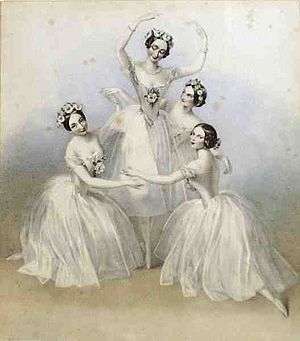Marie Taglioni
| Marie Taglioni | |
|---|---|
 Taglioni in a lithograph of 1839 | |
| Born |
23 April 1804 Stockholm, Sweden |
| Died |
22 April 1884 (aged 79) Marseille, France |
| Nationality | Italian/Swedish |
| Occupation | danseuse |
| Years active | 1824–1847 |
| Known for | La Sylphide, other romantic ballets |
| Parent(s) | Filippo Taglioni and Sophie Karsten |
| Relatives | Paul Taglioni (brother) |
Marie Taglioni (23 April 1804 – 22 April 1884) was a ballet dancer of the Romantic ballet era, a central figure in the history of European dance. She was one of the most celebrated ballerinas of the romantic ballet, which was cultivated primarily at Her Majesty's Theatre in London, and at the Théâtre de l'Académie Royale de Musique of the Paris Opera Ballet. She is credited with (though not confirmed) being the first ballerina to truly dance en pointe.
Early life
Taglioni was born in Stockholm, Sweden, to Italian choreographer Filippo Taglioni and Swedish ballet dancer Sophie Karsten, maternal granddaughter of the Swedish opera singer Christoffer Christian Karsten and of the Polish opera singer and actress Sophie Stebnowska. Her brother, Paul (1808–1884), was also a dancer and an influential choreographer; they performed together early in their careers.[1]
Marriage
Taglioni was married to Comte Auguste Gilbert de Voisins on 14 July 1832, but separated in 1836. The couple had one daughter, Eugenie-Marie Edwige.
Training
Taglioni moved to Vienna with her family at a very young age where she began her ballet training under the direction of her father. Filippo created a rigorous training regimen for his daughter that consisted of holding positions for 100 counts and engaging in two hour long intervals of conditioning exercises, adagio, and jumping combinations. In Vienna, Marie danced her first ballet choreographed by her father titled "La Reception d'une Jeune Nymphe à la Cour de Terpsichore". [2]
Career

Before joining the Paris Opéra, Taglioni danced in both Munich and Stuttgart, and at age 23 debuted in another ballet choreographed by her father called "La Sicilien" that jump-started her ballet career. Taglioni rose to fame as a danseuse at the Paris Opéra when her father created the ballet La Sylphide (1832) for her. Designed as a showcase for Taglioni's talent, it was the first ballet where dancing en pointe had an aesthetic rationale and was not merely an acrobatic stunt, often involving ungraceful arm movements and exertions, as had been the approach of dancers in the late 1820s. [3]
Pas de Quatre

In 1827 Taglioni left the Ballet of Her Majesty's Theatre to take up a three-year contract in Saint Petersburg with the Imperial Ballet (known today as the Kirov/Mariinsky Ballet). It was in Russia after her last performance in the country (1842) and at the height of the "cult of the ballerina", that a pair of her pointe shoes were sold for two hundred rubles, reportedly to be cooked, served with a sauce and eaten by a group of balletomanes.[4]
In July 1845, she danced with Lucile Grahn, Carlotta Grisi, and Fanny Cerrito in Jules Perrot's Pas de Quatre, a ballet representing Taglioni’s ethereal qualities that was based on Alfred Edward Chalon’s lithographic prints. Pas de Quatre was originally choreographed to be presented to Queen Victoria.
Retirement, last years, and death
Taglioni retired from performing in 1847; for a time she took up residence at the Ca' d'Oro on the Grand Canal in Venice. When the ballet of the Paris Opéra was reorganized on stricter, more professional lines, she was its guiding spirit. With the director of the new Conservatoire de danse, Lucien Petipa, and Petipa's former pupil, the choreographer Louis Mérante, she figured on the six-member select jury of the first annual competition for the corps de ballet, held 13 April 1860.
Her only choreographic work was Le papillon (1860) for her student Emma Livry, who is remembered for dying in 1863 when her costume was set alight by a gas lamp used for stage lighting. Johann Strauss II composed the "Marie Taglioni Polka" (Op. 173) in honour of Marie Taglioni's niece, Marie "Paul" Taglioni, also known as "Marie the Younger". The two women, having the same name, have often been conflated, or confused with each other.[5][6]
Later in England, she taught social dance and ballroom to children and society ladies in London; she also took a limited number of ballet pupils. She resided at #14 Connaught Square, London from 1875 to 1876.
Death
Taglioni died in Marseille on 22 April 1884,[3] the day before her 80th birthday.[7]
See also
References
- ↑ Profile, abitofhistory.net; accessed 18 February 2016.
- ↑ Chisholm 1911.
- 1 2 Secombe 1898.
- ↑ Kassing, Gayle (2007). History of dance: an interactive arts approach. Human Kinetics. p. 131.
- ↑
 This article incorporates text from a publication now in the public domain: Chisholm, Hugh, ed. (1911). "Taglioni, Maria". Encyclopædia Britannica. 26 (11th ed.). Cambridge University Press.
This article incorporates text from a publication now in the public domain: Chisholm, Hugh, ed. (1911). "Taglioni, Maria". Encyclopædia Britannica. 26 (11th ed.). Cambridge University Press. - ↑
 This article incorporates text from a publication now in the public domain: Seccombe, Thomas (1898). "Taglioni, Marie". In Lee, Sidney. Dictionary of National Biography. 55. London: Smith, Elder & Co.
This article incorporates text from a publication now in the public domain: Seccombe, Thomas (1898). "Taglioni, Marie". In Lee, Sidney. Dictionary of National Biography. 55. London: Smith, Elder & Co. - ↑ Marie Taglioni, the Italian Ballerina, lifeinitaly.com; accessed 18 February 2016.
Sources
- Wurzbach, Constantin von (1881). "Taglioni, Marie". Biographisches Lexikon des Kaiserthums Oesterreich (in German). 43. Vienna. pp. 17–23.
External links
 Media related to Marie Taglioni at Wikimedia Commons
Media related to Marie Taglioni at Wikimedia Commons- Marie Taglioni (1804–1884): A life on toe tip (web presentation of the Taglioni collection in the Netherlands Music Institute)